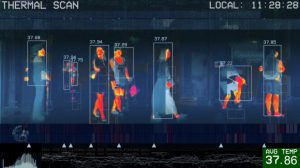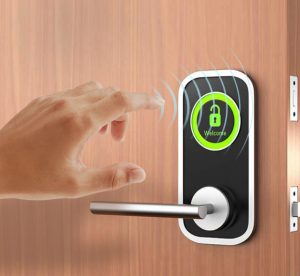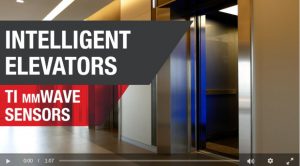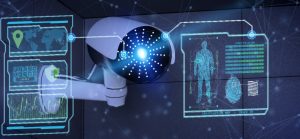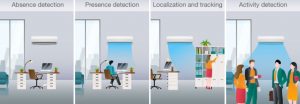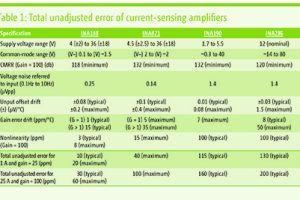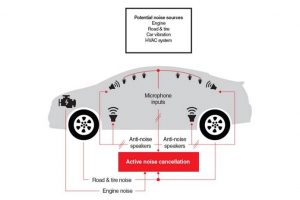But travellers with a temperature above 38°C may be familiar with the new thermal screening technology deployed there this summer. That’s because airport officials are advising anyone with a fever not to fly.
While the initial screening program at LAX is voluntary, it may be a harbinger of more proactive efforts to identify individuals who may have a fever when entering public facilities and office buildings. Welcome to the new normal. In the wake of the COVID-19 pandemic, building designers and managers are deploying technology to make buildings safer and more efficient. Smart building technology, from visitor screening to demand-controlled ventilation, is helping protect an increasingly health-conscious public.
Thermal imaging for high volume screening
A major challenge for building managers today is how to protect public health so that people are comfortable approaching and being inside a building.
Thermal imaging as seen in figure 1 is one of the tools building managers use to increase public safety in high-traffic areas. Handheld and walkthrough systems – similar in appearance to metal detectors – quickly perform contactless temperature checks to screen for individuals running a fever.
Figure 1: An example of thermal imaging
Thermal screening enables building managers to oversee people coming into a building and ensure that it’s safe to let them in. Infrared energy sensors in thermal cameras automate the process of screening large groups, making the process seamless and scalable.
One of the challenges of thermal imaging systems is that they have not historically been part of a building’s initial design or security system. But thermal systems can be easily retrofitted into an existing building or included in new construction plans. Either way, thermal imaging sensors need to be lightweight and compact, while delivering high performance with low power consumption.
Using technology to facilitate contactless access
Contactless access (as shown in figure 2) to rooms, elevators and other high-traffic areas is another way in which building automation can protect the health of a building’s occupants. One of the challenges for smart building designers is finding ways to reduce the need for people to touch shared surfaces, such as door handles and elevator buttons.
Figure 2: An example of a contactless access system
Proximity- sensing technology is one example of how automation helps make buildings safer for people to move around while following social distancing guidelines. Some intelligent elevators, for example, use millimeter-wave (mmWave) technology to facilitate contactless access.
Commercial mmWave sensors use short-wave radar in the 30- to 300-GHz spectrum to detect the range, velocity and angle of both objects and people. This technology is a good fit for automated access.
Sensors that detect whether to open or close elevator doors require integrated systems that combine computer vision with machine learning to facilitate near-real-time decision-making. The nuances of detection can include opening elevator doors based on a person’s angle and velocity, indicating their intent to enter. Once inside the elevator, occupants can use voice commands, a smartphone or proximity-based switches to instruct the elevator what floor to stop on, making the entire experience hands-free.
Rapid deployments of artificial intelligence for smart building applications are also on the horizon, including voice-based and facial-recognition technology. Together, these advancements enable individuals to navigate buildings more readily, with less need for physical contact.
Deploying sensors for occupancy control
Another application in which mmWave sensors are proving beneficial is occupancy tracking, which includes both counting people and monitoring their movements inside a building. Figure 3 shows an example of a camera that can be used for this application.
Figure 3: An example of a building access system performing object detection
Because mmWave uses high-frequency radio signals, it can overcome a wide range of environmental challenges, from too much sunlight to low-light conditions. It also can “see” through drywall and other conventional materials. When integrating mmWave into systems with machine learning capabilities, it becomes possible to count and track multiple people simultaneously. This capability can be beneficial for controlling access to buildings or rooms with limited capacity.
Sensor nodes placed at various points throughout a building enable the tracking of every place a person displaying contagious symptoms has been, enabling building managers to sanitize specific locations and facilitating contact tracing.
The key to contact tracing within buildings is a network that integrates sensors with very low power requirements, fast and reliable connectivity, and the ability to process data at the edge.
HVAC automation
Automated heating, ventilation and air-conditioning (HVAC) systems are another tool that can help ensure indoor health and safety. Smart HVAC systems as shown in figure 4 overcome the challenges associated with manual control and monitoring. Automated systems, featuring Internet of Things connectivity, can manage everything from temperature and humidity levels to damper control and fresh air circulation.
HVAC automation can improve a building’s energy efficiency as well occupants’ safety and comfort. According to a report from the American Society of Heating, Refrigerating and Air-Conditioning Engineers, it is possible to enhance building safety by improving the integration of fresh air, minimizing the recirculation of stale air, and filtering central air. Figure 4 shows an example of
Ultra-low-power wireless environmental sensors are essential for intelligent building-management systems. Smart building systems rely on secure, low-power, multiband sensor networks. One example of a smart HVAC application uses the SimpleLink™ microcontroller platform to manage a network of air-quality sensors and wired dampers. The system connects to an Ethernet-enabled HVAC system controller, and then to the cloud.
Figure 4: Examples of how HVAC system in a connected building
Conclusion
An increasing focus on health and safety means that smart building technology will become an increasingly important part of both retrofitted and new construction. It is possible to retrofit existing buildings with wireless sensors and edge-processing systems. Both old and new buildings can benefit from integrated networks that automate everything from visitor screening to HVAC systems.
Ultimately, smart building networks reflect a convergence of machine vision sensors, power management systems, and embedded processing capabilities. When we talk about integration, it doesn’t mean putting everything into one system. Integration is about developing smarter, more intelligent networks.
Learn more about building automation technology.
Apoorva Awasthy, Texas Instruments
 Electronics Weekly Electronics Design & Components Tech News
Electronics Weekly Electronics Design & Components Tech News
